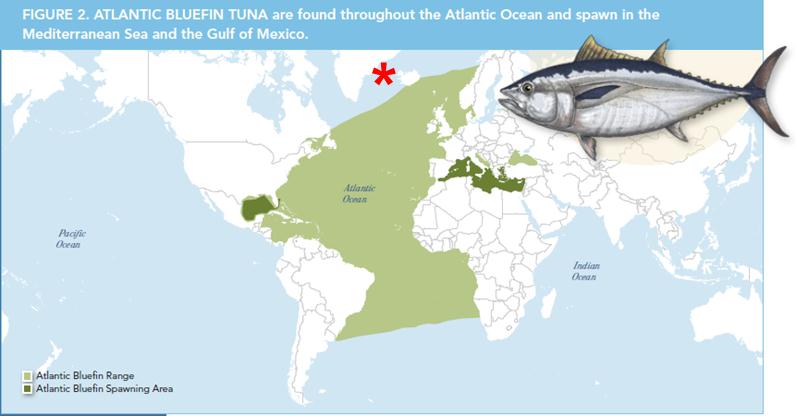Warmer temperatures, and prey species which are also moving north, can be reasons why bluefin tuna were found in the Denmark Strait east of Greenland, according to a DTU Aqua investigation which has described how climate change is affecting migration behaviour and distribution of bluefin tuna.
On a warm summer day in August 2012, Greenlandic fishermen caught an unusual catch while conducting an exploratory fishery for mackerel.
Three large bluefin tuna, each weighing around 100 kg, were among the several tonnes of mackerel that were caught that summer. The presence of bluefin tuna in waters near Greenland is a very rare event, and there are no other scientific reports of its presence so far north as the Denmark Strait. The most recent report of its occurrence near Greenland was a stranding in 1900 in the southwesternmost tip of Greenland at Qaqortoq (formerly known as Julianehåb).
-Bluefin tuna usually search for prey in areas where surface temperatures are warmer than 11 C. However, because temperatures in August 2012 in the Denmark Strait were so warm, and because one of its favorite prey species, mackerel, had already expanded its range into the region, it is likely that bluefin tuna has expanded or is presently expanding its habitat to more northerly regions, explains professor Brian MacKenzie, who together with senior scientist Mark Payne, senior scientist Jesper Boje (both from DTU Aqua), senior scientist Jacob Højer (Danish Meteorological Institute) and Department Head Helle Siegstad (Greenland Nature Institute, GNI), has been investigating the reasons why bluefin tuna and its summer dining menu are on its way to more northerly regions than usual.
The investigation, which was conducted as part of the EU projects Euro-Basin and NACLIM at the Centers for Ocean Life and Macroecology, Evolution and Climate, has just been published in the peer-reviewed scientific journal Global Change Biology.
Catch can help explain disappearance from Danish waters
The reason why Brian MacKenzie and his colleagues initially became interested in these tuna bycatches was to document changes in its migration behaviour and distributional range, and how these are being influenced by climate change and the abundances of both bluefin tuna themselves and their prey.
-The scientific community does not have a solid understanding of the factors that affect the migrations and geographical distribution of bluefin tuna and many other migratory species, but new knowledge like this can potentially help explain the unsolved mystery of why bluefin tuna disappeared from waters near Denmark and in the Norwegian Sea during the 1960s, and especially when they might come back, says Brian MacKenzie, noting that in addition to the appearance in Denmark Strait in 2012, Iceland and Norway have been allocated new fishing quotas (30 tonnes each) for the species in 2014.
-The new quota allocations are presumably because the species has begun to expand its northerly feeding areas farther north. If summer temperatures continue to increase during this century, and if both bluefin tuna and its prey species are managed in sustainable ways, then it is likely that bluefin tuna could become a regular summer visitor in east Greenland waters, at least as far north as the Denmark Strait, states Brian MacKenzie.
Further investigations needed to estimate population
The Denmark Strait is normally a much colder area without warm-adapted species such as bluefin tuna. How many tuna were present in summer 2012 is unknown.
-The data we have available are too limited to estimate how many tuna came so far north, but because the species is a schooling species, with schools having ca. 10-100 individuals, and because the fishermen caught the three tuna in the same haul, it is likely there were many more present, Brian MacKenzie said.
- We are planning further investigations to determine whether this new migration behaviour toward more northern waters could be the result of an increase in the total population of Bluefin tuna, the DTU Aqua-professor stress.
-Regardless of whether the stock has increased or not, climate-related changes in distributions of commercial fish like these we have seen already for mackerel and herring, will mean that international management authorities will need to develop new fishery and ecosystem management plans, says co-author Helle Siegstad, Head of the Department for Fish and Shellfish, GNI.
-We have already seen during the past few years with the case of the expansion of mackerel and herring into waters near the Faroe Islands, Iceland, Norway and now Greenland how complicated the discussions between jurisdictions can become. It will be important in future that we can provide authorities with a solid scientific and data basis, on for example bluefin tuna, when they are making new fishery management decisions, concludes Brian MacKenzie.
Read the
scientific article in Global Change Biology.
Read final draft of scientific article in Global Change Biology (does not require subscription)
The investigation has been conducted within two EU projects (Euro-Basin and NACLIM) on how climate change influences life in the ocean, at two research centers (Center for Ocean Life and Center for Macroecology, Evolution and Climate, which are supported respectively by the the Villum Kann Rasmussen Foundation and the Danish National Research Foundation (Dansk Grundforskningsfond).

Record-high water temperature in the summer of 2012 was likely the main reason why three bluefin tuna were caught in the Denmark Strait (catch location marked with red star) and far from their normal summer feeding areas.
Map source: Boustany, A. 2011. Bluefin Tuna: The State of the Science. Ocean Science Division, Pew Environment Group, Washington, DC.